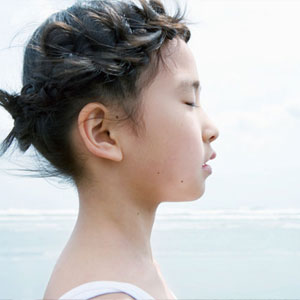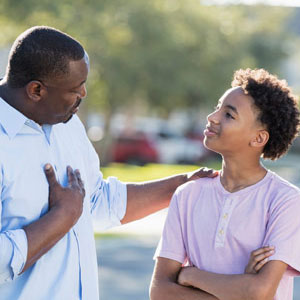Relaxation Techniques for Kids With Serious Illness
If your child has a serious illness, you might wonder how you can help manage any related stress or anxiety. Relaxation exercises can help relieve stress for both you and your child.
Most can be done in a few minutes at home, or even at a crowded hospital. They can lessen the physical symptoms of many illnesses and help your child (and you!) regain a sense of control and confidence in trying times.
Not every relaxation technique will work for every child, and some may not be recommended for certain conditions. Talk to your doctor to find out which might be best for your child.
How Can My Child Practice Focused Breathing?
Pain and stress can leave a child breathing faster and shallower, or even holding their breath — all of which can keep the stress response going and heighten the intensity of pain. Paying attention to breathing can help calm the mind.
Many types of breathing exercises can help. Try this one with your child:
- Step 1. Sit or lie comfortably and put one hand on your stomach, the other on your chest.
- Step 2. Close your eyes and try to relax all your muscles, one by one, from the tips of your toes to the top of your head. Don't forget to relax the muscles in your face, neck, and jaw. You may be storing a lot of tension there.
- Step 3. Breathe deeply and regularly for several minutes— and try to make your stomach (abdomen) rise and fall, not only your chest. This will help you deepen your breath.
- Step 4. Pay attention to each breath. Try to turn all your thoughts to each inhale … exhale. As you breathe out, imagine the tension leaving your body with the breath.
- Step 5. Notice when your mind wanders, and gently bring your focus back to your breath. Imagine letting go of each distracting thought like a balloon drifting away, or any other imagery that works for you.
How Can My Child Practice Mindful Word (Mantra) Meditation?
This technique asks a person to repeat a word, phrase, or prayer to help focus the mind and create a sense of calmness and well-being. It's normal for distracting thoughts to come up during this exercise. Encourage your child to gently let go of these and bring the mind back to the word or phrase.
Here’s how it works:
- Step 1. Pick a focus word, phrase, sound, or prayer such as "om," "one," "peace," “quiet,” “calm,” or anything that resonates with your child.
- Step 2. As you breathe, say the focus word silently to yourself as you exhale.
- Step 3. Continue for 5 or 10 minutes, ideally building up to 10 to 20 minutes for each session.
- Step 4. When you're finished, do not stand up right away. Keep sitting quietly for a bit, letting other thoughts back into your mind. Open your eyes, but stay sitting for another minute before getting up.
To help you get into the right mindset, you may want to try the focused breathing exercise above first, then move into this exercise. When practicing, go at your own pace, and remember that relaxation tends to come more easily when you’re not trying as hard.
How Can My Child Practice Guided Imagery?
A growing body of medical research suggests that guided imagery also can help lessen pain and anxiety.
Guided imagery (also called "visualization") often works best when a person starts with a few minutes of focused breathing. As for the actual imagery, you have a variety of options for what you’d like to visualize. Here are a few good starting points:
- You could picture a place, real or imagined, that makes you feel safe and calm, and imagine being in the place.
- You could picture your thoughts as clouds passing through the sky, or leaves floating by on a stream, to help you calmly release them.
- Picture a color that you find soothing.
Some children find this exercise more helpful when they are guided by a parent, a live instructor, an app, or a video.
What Is Music Therapy?
Music therapy is the research-based use of music to promote mental and physical well-being. Kids who try music therapy have lowered heart rates, blood pressure, and anxiety. Many hospitals have a licensed music therapist who can work with kids to develop a customized treatment plan.
There are many ways to practice music therapy at home. Your child can:
- Listen to music while relaxing (or doing any other relaxation technique).
- Draw or paint while listening to music.
- Actively play while listening to music.
- Dance or move the body to music.
- Drum a beat with the hands (or use hand drums).
- Play an instrument.
- Sing along to a favorite song.
- Improvise or write original music.
- Write original song lyrics or new lyrics for an old song.
Your child doesn’t need to have any musical training to practice music therapy. The point isn’t to create flawless music, but to relax and have fun. Choose music you both enjoy and try any of the above techniques with your child.
What Is Energy Therapy?
Energy therapy is based on the understanding that electrical currents are in all living organisms. The idea is that gentle, light touch or above-the-body hand movements can redirect these energy currents to places where they’re needed to bring the body into balance or harmony.
Energy therapy has been scientifically studied, and findings note that it promotes healing as it helps kids feel more relaxed, less anxious, and less bothered by pain. It also empowers them to feel like they are in control and can do something to help themselves feel better.
Many different types of energy therapy are practiced all over the world, such as:
- Healing Touch
- Reiki (from Japan)
- Johrei (from Japan)
- Qi gong (from China)
- acupressure (from China)
- acupuncture (from China)
- chakra alignment (from India)
Many hospitals offer Healing Touch along with standard treatments for anxiety, pain, or other medical problems. You also might be able to learn how to practice Healing Touch at home.
What Is Massage Therapy?
The benefits of massage are well-known, offering muscle relaxation and increased blood flow and oxygen to help relieve pain and stress. Some types of massage are not recommended for certain types of conditions, so check with your doctor first before trying these techniques.
The most common forms of massage used in complementary medicine include:
- Swedish massage. Therapists use their hands to move muscles and joints with long, gliding strokes, tapping movements, friction (made by moving hands quickly), and kneading. Massage oils may be used, so tell the therapist about any allergies or sensitivities your child has.
- Deep-tissue massage. Many of the same techniques are used as in Swedish massage, but therapists apply more pressure to specific areas, concentrating on the deeper layers of muscles and connective tissue.
- Trigger-point massage. Like deep-tissue massage, this technique massages deeper layers of tissue, focusing on what therapists call trigger points ("knots") within the or muscles that usually feel painful when pressed.
Many hospitals have massage therapists to offer massages to both patients and their family members, so find out if massage therapy is offered at your hospital.
What Else Should I Know?
These are just a few of the many methods designed to help patients and families cope with pain and anxiety. Many people find that yoga, stretching, or light, gentle exercise also helps to quiet the mind and soothe the body.
To learn more about relaxation techniques, talk to your child's doctor.
You can also find other tools to help with coping in the Health Care Tool Box.


